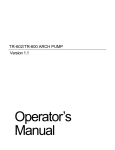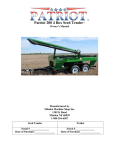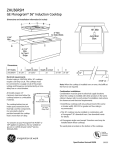Download 1.1. TROUBLESHOOTING ISSUES STORM SEED TREATER
Transcript
STORM SEED TREATER TROUBLESHOOTING INSTRUCTIONS MAY 2, 2014 The STORM should be operated within an acceptable temperature range, with a consistent and sufficient power source. Best results are obtained when ambient, seed, and treatment temperature are above 10 degrees Celsius, powered by a dedicated 15A power source that delivers between 100 and 120 VAC (measured at the STORM Control Box plug) during full operation. Extension cords should be 12 gauge or heavier and should not exceed 150 feet in total length. Use a 3000 watt generator if power availability is limited. Ensure that extension cord ends are not worn or damaged to ensure a dependable power supply. Intermittent power due to worn or damaged extension cords can lead to erratic Control Box function and inaccurate seed treatment results. 1.1. TROUBLESHOOTING ISSUES Table 2 lists issues related to the STORM seed treatment section. Table 2 Seed Treating Section Issues Issue Type Seed delivery issues Pump issues Seed coverage issues Treatment build-up issues Conveyor speed issues Common Issues Page Number seed delivery is outside of the expected +/-5% pump won't prime pump output is fluctuating pump output is inconsistent and outside of the expected +/-5% pump is difficult to calibrate pump won’t turn, or turns erratically seed coverage is poor page 3 page 3 page 3 page 3 excessive build-up in application chamber build-up of treatment on metering conveyor belt system won’t operate at higher conveyor speeds page 6 page 6 page 7 page 3 page 3 page 6 1.3. SEED DELIVERY ISSUES SEED DELIVERY IS OUTSIDE OF THE EXPECTED +/-5% 1. Conveyor intake wiper is out of adjustment: Check orientation and seating of the wiper, and ensure wiper height is 1-5/8”. The bevelled corners of the intake wiper should be directed upwards and the flat section should be resting flush on the plastic wear strips on either side of the seed flow area. 2. Cleated conveyor belt is slipping on the drive rollers: • Adjust belt tension and tracking. Ensure side bearing mount plates are free to slide as required. • Ensure that the cleat travel is not being impeded by an object protruding into the seed travel area. 3. Drive chain is slipping: Check condition of chain and drive sprockets. Adjust chain tension. 4. Inconsistent grain feed rate to conveyor: • During operation, ensure that the metering convey cleats are full by checking the inspection window on the top of the conveyor. • Check for blockage of the conveyor intake grating. • Ensure that the seed supply gate is fully opened and completely flooding the intake of the conveyor. • Center the conveyor intake under the seed supply opening. • If the conveyor is not being flood fed, like when supplying the conveyor from a truck with a rear opening, the height of the grain in the intake must be the same as the height of the fully deployed and flooded intake hopper. 5. Electronics not achieving proper conveyor motor speeds: Consult Table 3 on page 7 for the expected conveyor speed for the seed type that is being utilized. • Check Conveyor Drive ratio. It should be 15:33. If not adjust. • For March 24, 2014 software, ensure that the Seed Flow Correction is set at 1000. • For software versions newer than March 24, 2014, the Seed Flow Correction number may have been inadvertently adjusted. Return the seed flow correction number to 1000 if it was not been adjusted on purpose (such as “Consistent metering inaccuracy:” below. 6. Consistent metering inaccuracy: Metering inaccuracies may occur due to manufacturing differences or bin feed conditions and results in the metering conveyor being consistently inaccurate to the same degree. For software versions newer than March 24, 2014 the seed flow correction can be adjusted when the meter is consistently delivering a different amount than the electronic display indicates. All other options should be explored before making this adjustment. 2 The default value of 1000 indicates that the meter is delivering 100% of the expected seed flow. A higher number slows the conveyor. A lower number speeds up the conveyor. If the conveyor consistently over-meters seed (delivers more seed than the STORM electronic display indicates), increase the seed flow correction by the percentage amount the unit is out. If the conveyor consistently under-meters seed (delivers less seed than the STORM electronic display indicates), decrease the seed flow correction by the percentage amount the unit is out. For example: The STORM unit is consistently inaccurately metering jobs to the same degree for all jobs. In the last job, the weight of seed was determined to be 19,500 lbs, but the STORM display indicates it was 20,000 lbs. The unit is under-metering. Multiply the seed flow correction of 1000 by 19,500 lbs and divide by 20,000 and enter the value of 975 as the new seed flow correction. 1.4. PUMP ISSUES See Table 2 for common pump-related issues, and lists of possible problems. Table 2 Common Pump Issues Common Pump Issues pump won't prime pump output is fluctuating pump output is inconsistent and outside of the expected +/-5% Possible Problem 1. Pump shoe is not fully engaged: 2. Pump occlusion dial set incorrectly: 3. There is an air leak in the fittings on the intake line: 4. The line is restricted on the intake or output side of the pump: 6. Pump is operating too slowly:. 9. Product condition is inconsistent: 10. Product is too thick to meter properly: 11. The pump is damaged: 1. Pump shoe is not fully engaged: 2. Pump occlusion dial set incorrectly: 3. There is an air leak in the fittings on the intake line: 4. The line is restricted on the intake or output side of the pump: 5. Pump is operating at too high of a pressure: 6. Pump is operating too slowly: 7. Pump is operating too fast: 8. Calibration was performed at a different treating speed than the operational speed. 9. Product condition is inconsistent: 10. Product is too thick to meter properly: 11. The pump is damaged: 3 Table 2 Common Pump Issues Common Pump Issues pump is difficult to calibrate pump won’t turn, or turns erratically Possible Problem 1. Pump shoe is not fully engaged: 2. Pump occlusion dial set incorrectly: 3. There is an air leak in the fittings on the intake line: 4. The line is restricted on the intake or output side of the pump: 7. Pump is operating too fast: 9. Product condition is inconsistent: 10. Product is too thick to meter properly: 11. The pump is damaged: 6. Pump is operating too slowly: 11. The pump is damaged: 1. Pump shoe is not fully engaged: Check that the pump lever is fully engaged in the lever catch. 2. Pump occlusion dial set incorrectly: Adjust the pump occlusion dial on the top of the pump as far clockwise as possible. 3. There is an air leak in the fittings on the intake line: • Check that the dry break couplers are fully engaged. Reengage if required. • Check the condition of the pump hose, especially inside of the pump and on the intake side of the pump. Ensure it is not cracked. • Check for loose connections on the intake side of the pump. Tighten loose fittings and hose clamps. Check for cracked fittings or fittings that may not be have been assembled with pipe thread sealant. Replace and reassemble as necessary. • Ensure the container attached to the pump is free of air leaks, including the connector assembly and drop tube. 4. The line is restricted on the intake or output side of the pump: • Check the condition of the pump hose. Ensure it has not collapsed, become plugged, or excessively worn. • Check filter and nozzles for plugging. • If in freezing conditions, check for frozen deposits in the lines. • If using a slurried product, check for product settling in the lines. 5. Pump is operating at too high of a pressure: Ensure system is operating at 20 psi or lower. Lower treating parameters, such as treating speed, to reduce system pressure. 6. Pump is operating too slowly: Some application rates, combined with low seed densities and slow treating speeds can result in slow pump operating speeds. • Pump speeds under 35 rpm can result in inconsistent flows. If possible, increase product application rate by diluting in order to increase pump speeds. 4 • Increase treating speed to increase pump speed if operating below 30 bushels per minute. 7. Pump is operating too fast: Viscous (thick) products with high application rates, combined with high seed densities and high treating speeds can result in the pump operating inefficiently. Pump speeds over 400 rpm can result in inconsistent flows. Decrease treating speed to reduce pump speed. 8. Calibration was performed at a different treating speed than the operational speed. Operate the STORM at the same treating speed as the pre-configured desired treating speed set in the job parameters. 9. Product condition is inconsistent: • Inadequate mixing may result in product stratification. Ensure that the product has been properly mixed prior to pumping the product with the STORM. • Over-mixing can cause some products to foam. Consult with the product manufacturer for proper handling recommendations 10. Product is too thick to meter properly: • Dilute product, if possible, to reduce viscosity. Recalibrate as required to ensure accuracy of application. • Some treatment products change in viscosity with temperature. Ensure calibrations are performed for the conditions at the time of treating. 11. The pump is damaged: • Pump may be damaged or warped. Test by removing hose and spinning by hand. If binding is evident in rotation of rotor or rollers inside the pump, then adjust mounting screws to relieve problem. Replace the pump if required. • Ensure that the pump coupler is installed correctly. 1.3. SEED COVERAGE SEED COVERAGE IS POOR 1. Nozzles are plugged: Check for plugged nozzles, and clean as required. 2. Nozzle(s) are misdirected: Ensure nozzles are oriented correctly and spraying the full grain curtain. 3. Nozzle(s) are not creating a spray pattern: Excessively low pump flow (800 ml/min or lower per nozzle) can result in a poor spray pattern, depending on the treatment type (this issue can commonly affect treatment of barley and oats). Increase treating parameters to gain an improved spray pattern. If product application rates are low, consider combining flows or diluting product to increase flow rate through the nozzles. 4. Application Rates are lower than 300 ml/100 kg of seed: 5 • Consider increasing dilution of treating product or use second pump (if not being utilized) to add water to application. • Coverage is best for Wheat, Barley and Oats at application rates of 400 to 600 ml/100kg. 5. Application rates are not being obtained: Check seed delivery and pump rates and ensure they are being met. 6. Seed condition is affecting coverage: Dusty seed, dry seed, and frozen seed can affect coverage of many seed treatments. 7. Treating speed is not optimal for mixer speed: Running the mixer (boot flight) too quickly can result insufficient mixing and result in poor coverage. Reduce the auger throttle until coverage improves. 8. Treatment product is too thick: Thick treatment products may not cover seed adequately. Consult treatment product manufacturer for recommendations and dilute to reduce viscosity if possible. 1.4. TREATMENT BUILDUP EXCESSIVE BUILD-UP IN APPLICATION CHAMBER 1. Seed condition is poor (dusty, dry, etc.): Dirty or dusty seed will cause build-up. Avoid using excessively dirty or dusty seed. 2. Treatment product is too thick: Thick treatment products can increase build-up. Consult treatment product manufacturer and dilute treatment if possible. BUILD-UP OF TREATMENT ON METERING CONVEYOR BELT 1. Treatment is flowing when seed is not: Do not operate the pumps with no seed flowing, or treatment will splash up onto the conveyor belt. 2. Seed is dusty: Seed treatment will readily bind to the dust in the seed. These airborne particulates may stick to the conveyor belt. 3. Nozzle(s) are misdirected: Ensure nozzles are oriented correctly and spraying the full grain curtain. 6 1.5. CONVEYOR SPEED ISSUES SYSTEM WON’T OPERATE AT HIGHER CONVEYOR SPEEDS 1. Pump speed limit of 650 rpm has been met: Lower product dilution if possible, or split treatment application between two pumps. 2. Insufficient power supply: Check advanced diagnostics tab during operation for voltage condition. If low (less than 100 VAC), ensure that the power supply is sufficient. Extension cords should be 12 gauge or heavier and should not exceed 150 feet in total length. Utilize a 3000 watt generator if power availability is limited. 3. Conveyor out of adjustment causing excessive drag: An improperly adjusted conveyor can increase power requirements. Adjust conveyor tension and/or tracking. 1.6. EXPECTED CONVEYOR MOTOR SPEED See Table 3 for the expected conveyor motor speeds. Table 3 Expected Conveyor Motor Speeds (RPM) Treating Speed bu/min 15 17.5 20 22.5 25 27.5 30 Wheat (RPM) Barley (RPM) 1353 1588 1846 2128 2434 2763 3116 1370 1619 1891 2184 2501 2839 3201 Oats (RPM) Peas (RPM) Lentils (RPM) 1340 1525 1777 2097 2483 2938 3459 1379 1625 1908 2230 2588 2985 3419 1309 1532 1776 2041 2328 2637 2966 1.4. SEED DENSITY Table 4 provides seed densities based on the use of a standard 0.5 L cup filled by a cox funnel according to standard practice. Data for Wheat, Barley, Oats, and Flax has been obtained from the Canadian Grains Commission and is corrected for grain compaction. For further information consult www.grainscanada.gc.ca. 7 Data for wheat that is shown in red is based on predicted values of the Canadian Grains Commission data. Actual values may vary. Table 4 Seed Density (Based on Avery Bushel Measure) Measured Peas & Wheat Barley Oats Flax Lentils g/0.5 L lbs/bu lbs/bu lbs/bu lbs/bu lbs/bu 179 28.7 32.0 180 28.9 32.1 181 29.0 32.3 182 29.2 32.4 183 29.4 32.6 184 29.5 32.8 185 29.7 32.9 186 29.8 33.1 187 30.0 33.2 188 30.2 33.4 189 30.3 33.6 190 30.5 33.7 191 30.6 33.9 192 30.8 34.0 193 31.0 34.2 194 31.1 34.4 195 31.3 34.5 196 31.4 34.7 197 31.6 34.8 198 31.8 35.0 199 31.9 35.2 200 32.1 35.3 201 32.2 35.5 202 32.4 35.6 203 32.6 35.8 204 32.7 35.9 205 32.9 36.1 206 33.0 36.3 207 33.2 36.4 208 33.4 36.6 209 33.5 36.7 210 33.7 36.9 211 33.8 37.1 212 34.0 37.2 213 34.2 37.4 214 34.3 37.5 215 34.5 37.7 216 34.6 37.9 217 34.8 38.0 218 35.0 38.2 219 35.1 38.3 Measured Peas & Wheat Barley Oats Flax Lentils g/0.5 L lbs/bu lbs/bu lbs/bu lbs/bu lbs/bu 250 40.1 41.6 43.3 43.6 251 40.3 41.8 43.4 43.7 252 40.4 42.0 43.6 43.9 253 40.6 42.1 43.8 44.0 254 40.7 42.3 43.9 44.2 255 40.9 42.5 44.1 44.3 256 41.1 42.6 44.2 44.5 257 41.2 42.8 44.4 44.6 258 41.4 43.0 44.5 44.8 259 41.5 43.1 44.7 44.9 260 41.7 43.3 44.9 45.1 261 41.9 43.5 45.0 45.3 262 42.0 43.6 45.2 45.4 263 42.2 43.8 45.3 45.6 264 42.3 44.0 45.5 45.7 265 42.5 44.1 45.7 45.9 266 42.7 44.3 45.8 46.0 267 42.8 44.5 46.0 46.2 268 43.0 44.7 46.1 46.3 269 43.1 44.8 46.3 46.5 270 43.3 45.0 46.5 46.6 271 43.5 45.2 46.6 46.8 272 43.6 45.3 46.8 46.9 43.8 45.5 46.9 47.1 273 274 43.9 45.7 47.1 47.3 275 44.1 45.8 47.3 47.4 276 44.3 46.0 47.4 47.6 277 44.4 46.2 47.6 47.7 278 44.6 46.3 47.7 47.9 279 44.7 46.5 47.9 48.0 280 44.9 46.7 48.1 48.2 281 45.1 46.8 48.2 48.3 282 45.2 47.0 48.4 48.5 283 45.4 47.2 48.5 48.6 284 45.5 47.3 48.7 48.8 285 45.7 47.5 48.8 48.9 286 45.9 47.7 49.0 49.1 287 46.0 47.8 49.2 49.3 288 46.2 48.0 49.3 49.4 289 46.4 48.2 49.5 49.6 290 46.5 48.3 49.6 49.7 8 Table 4 Seed Density (Based on Avery Bushel Measure) Measured Peas & Wheat Barley Oats Flax Lentils g/0.5 L lbs/bu lbs/bu lbs/bu lbs/bu lbs/bu 220 35.3 38.5 221 35.4 38.7 222 35.6 38.8 223 35.8 39.0 224 35.9 39.1 225 36.1 39.3 226 36.2 39.5 227 36.4 39.6 40.0 228 36.6 39.8 40.2 229 36.7 39.9 40.3 230 36.9 40.1 40.5 231 37.0 40.2 40.6 232 37.2 40.4 40.8 233 37.4 40.6 40.9 234 37.5 40.7 41.1 235 37.7 40.9 41.2 236 37.9 41.0 41.4 237 38.0 41.2 41.6 238 38.2 41.4 41.7 239 38.3 41.5 41.9 240 38.5 41.7 42.0 241 38.7 40.1 41.8 42.2 242 38.8 40.3 42.0 42.3 243 39.0 40.5 42.2 42.5 244 39.1 40.6 42.3 42.6 39.3 40.8 42.5 42.8 245 246 39.5 41.0 42.6 42.9 247 39.6 41.1 42.8 43.1 248 39.8 41.3 43.0 43.2 249 39.9 41.5 43.1 43.4 321 51.5 53.0 53.5 54.5 322 51.6 53.1 53.7 54.6 323 51.8 53.3 53.9 54.8 324 52.0 53.5 54.0 55.0 325 52.1 53.6 54.2 55.1 326 52.3 53.8 54.4 55.3 327 52.4 53.9 54.5 55.4 328 52.6 54.1 54.7 55.6 329 52.8 54.3 54.9 55.7 330 52.9 54.4 55.0 55.9 331 53.1 54.6 55.2 56.0 332 53.2 54.8 55.4 56.2 333 53.4 54.9 55.5 56.3 334 53.6 55.1 55.7 56.5 Measured Peas & Wheat Barley Oats Flax Lentils g/0.5 L lbs/bu lbs/bu lbs/bu lbs/bu lbs/bu 291 46.7 48.1 48.5 49.8 49.9 292 46.8 48.3 48.7 50.0 50.0 293 47.0 48.5 48.8 50.1 50.2 294 47.2 48.6 49.0 50.3 50.3 295 47.3 48.8 49.2 50.4 50.5 296 47.5 48.9 49.3 50.6 50.6 297 47.6 49.1 49.5 50.8 50.8 298 47.8 49.3 49.7 50.9 50.9 299 48.0 49.4 49.8 51.1 51.1 300 48.1 49.6 50.0 51.2 51.3 301 48.3 49.7 50.2 51.4 302 48.4 49.9 50.3 51.6 303 48.6 50.1 50.5 51.7 304 48.8 50.2 50.7 51.9 305 48.9 50.4 50.8 52.0 306 49.1 50.6 51.0 52.2 307 49.2 50.7 51.2 52.3 308 49.4 50.9 51.4 52.5 309 49.6 51.0 51.5 52.6 310 49.7 51.2 51.7 52.8 311 49.9 51.4 51.9 52.9 312 50.0 51.5 52.0 53.1 313 50.2 51.7 52.2 53.3 314 50.4 51.8 52.4 53.4 315 50.5 52.0 52.5 53.6 316 50.7 52.2 52.7 53.7 317 50.8 52.3 52.9 53.9 318 51.0 52.5 53.0 54.0 319 51.2 52.7 53.2 54.2 320 51.3 52.8 53.4 54.3 378 60.6 62.2 379 60.8 62.3 380 60.9 62.5 381 61.1 62.7 382 61.3 62.8 383 61.4 63.0 384 61.6 63.1 385 61.7 63.3 386 61.9 63.5 387 62.1 63.6 388 62.2 63.8 389 62.4 63.9 390 62.6 64.1 391 62.7 64.3 9 Table 4 Seed Density (Based on Avery Bushel Measure) Measured Peas & Wheat Barley Oats Flax Lentils g/0.5 L lbs/bu lbs/bu lbs/bu lbs/bu lbs/bu 335 53.7 55.2 55.9 56.6 336 53.9 55.4 56.0 56.8 337 54.0 55.6 56.2 57.0 338 54.2 55.7 56.4 57.1 339 54.4 55.9 56.5 57.3 340 54.5 56.0 56.7 57.4 341 54.7 56.2 56.9 57.6 342 54.9 56.4 57.0 57.7 343 55.0 56.5 57.2 57.9 344 55.2 56.7 57.4 58.0 345 55.3 56.8 57.5 58.2 346 55.5 57.0 57.7 58.3 347 55.7 57.2 57.9 348 55.8 57.3 58.1 349 56.0 57.5 58.2 350 56.1 57.7 58.4 351 56.3 57.8 58.6 352 56.5 58.0 58.7 353 56.6 58.1 58.9 354 56.8 58.3 59.1 355 56.9 58.5 59.2 356 57.1 58.6 59.4 357 57.3 58.8 59.6 358 57.4 58.9 59.7 359 57.6 59.1 59.9 360 57.7 59.3 60.1 361 57.9 59.4 362 58.1 59.6 363 58.2 59.8 364 58.4 59.9 365 58.5 60.1 366 58.7 60.2 367 58.9 60.4 368 59.0 60.6 369 59.2 60.7 370 59.3 60.9 371 59.5 61.0 372 59.7 61.2 373 59.8 61.4 374 60.0 61.5 375 60.1 61.7 376 60.3 61.9 377 60.5 62.0 Measured Peas & Wheat Barley Oats Flax Lentils g/0.5 L lbs/bu lbs/bu lbs/bu lbs/bu lbs/bu 392 62.9 64.4 393 63.0 64.6 394 63.2 64.8 395 63.4 64.9 396 63.5 65.1 397 63.7 65.2 398 63.8 65.4 399 64.0 65.6 400 64.2 65.7 401 64.3 65.9 402 64.5 66.0 403 64.6 66.2 404 64.8 66.4 405 65.0 66.5 406 65.1 66.7 407 65.3 66.9 408 65.4 67.0 409 65.6 67.2 410 65.8 67.3 411 65.9 67.5 412 66.1 67.6 413 66.2 67.8 414 66.4 68.0 415 66.6 68.1 416 66.7 68.3 417 66.9 68.5 418 67.0 68.6 419 67.2 68.8 420 67.4 68.9 421 67.5 69.1 422 67.7 69.3 423 67.8 69.4 424 68.0 69.6 425 68.2 69.7 426 68.3 69.9 427 68.5 70.1 428 68.6 70.2 429 68.8 70.4 430 69.0 70.6 431 69.1 70.7 432 69.3 70.9 433 69.4 71.0 10 11
























